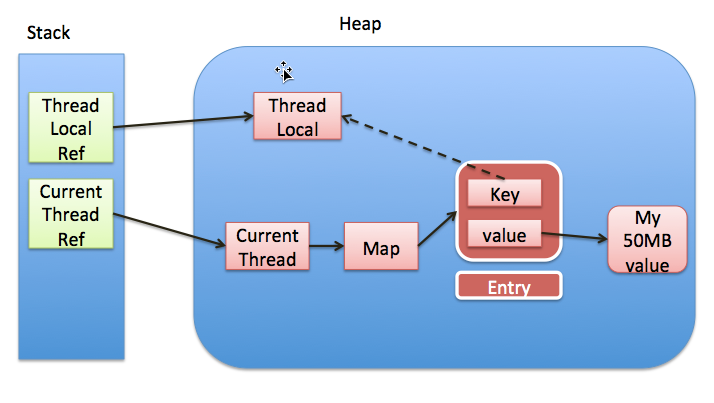在一次面试被问到了ThreadLocal,其间被问到了一个问题:ThreadLocal有什么缺陷。笔者不确定的回答:内存泄漏?面试官随即问道了:为什么会造成内存泄漏?笔者懵逼了,不知道该如何回答。下面在这片博客中通过源码(JDK1.8)来简单了解一下ThreadLocal的内部实现,好好看一下它为什么会造成内存泄露,以及在什么情况下会造成内存泄露。
概要
我们都知道ThreadLcoal可以将一个变量与当前线程绑定,使这个变量变成线程私有,以此来实现线程安全。通常我们会用它来避免多个函数或组件之间公用变量传递的麻烦。下面我们看一下javaDoc中对ThreadLocal的介绍。
1 | /** |
上面注释对ThreadLocal介绍的还是比较详细的,与我们了解的也差不多。我们主要看下最后一句,它说每个线程都会持有一个它的ThreadLocal变量副本的引用,如果这个线程一直存活,那么这个ThreadLocal实例就是可达的。这句话其实就透露了ThreadLocal内存泄露的其中一个原因,这里我们先按下不表,先来看看ThreadLocal的内部实现。
源码分析
ThreadLocal只有一个构造方法,同时也没有其他的工厂方法,我们先来看一下它的这个构造方法。
1 | /** |
可以看到这个构造方法是个空方法,只是用于new一个ThreadLocal对象,并没有进行数据的装配和底层存储结构的构造,这点上和HashMap差不多,采用了一种懒加载的方式,只有在真正在使用的时候才进行相关结构的构造。我么都知道ThreadLocal核心的有三个方法set,get,和remove方法,那么它底层结构的初始化应该是在调用这些方法时进行的。我们来看看这些方法的源码。
set方法
set方法的源码如下:
1 | public void set(T value) { |
我们看到它首先获得了一个当前线程的引用,并把它传递进了一个getMap函数,我们来看看这个getMap函数。
1 | /** |
可见这个方法只是返回一个当前线程持有的ThreadLocalMap对象,这里我们要明白一点,当前线程其实是持有这个ThreadLocalMap的引用的。下面再回到上面的set方法,它先得到当前线程持有的ThreadLocalMap对象,而在刚开始这个map肯定是空的,所以它会调用createMap方法,我们来看看这个方法。
1 | /** |
这里面new了一个ThreadLocalMap对象,并把它付给了当前线程持有的一个threadLocals。那么这个ThreadLocalMap是什么呢?它其实是ThreadLocal的静态内部类,ThreadLocal的数据存储和核心操作都是委托给它来实现的。看到这里或许有些同学会疑惑,既然只是存储变量副本,Set好像也能实现,为什么不用Set而用Map呢?毕竟Map要比Set复杂的多。这里我们就需要明白,这个Map是属于Thread而不是ThreadLocal的(虽然它是ThreadLocal的内部类),一个Thread可以有很多个ThreadLocal来存储多个变量,但它只会有一个ThreadLocalMap。
好了,下面我们来看一下上面这个ThreadLocalMap的构造方法里做了些什么。
1 | ThreadLocalMap(ThreadLocal<?> firstKey, Object firstValue) { |
首先它new了一个Entry类型的数组,初始容量是INITIAL_CAPACITY,这个值默认是16,我们再来看看Entry是什么。源码如下:
1 | static class Entry extends WeakReference<ThreadLocal<?>> { |
Entry是ThreadLocalMap的静态内部类,其实就是一个用来封装数据的结构体,类似于map中的桶的概念。这里需要注意的一点是,在这里ThreadLocalMap的key被包裹成了一个弱引用。我们再回到上面的构造方法,可以看到它new了一个数组后,然后对这个key进行了一顿操作,又是hash又是位运算的,这个具体我们下文再说,这里我们只需要知道它最终得到一个索引值作为上面数组的下标,通过这个我们可以索引到具体数据的位置。下面就是new一个Entry方法上面的数据中并初始化size和threshold。这里面size表示数组中entry的数目,threshold表示ThreadLocalMap扩容的阈值,这里面与HashMap不同的是这个阈值并不是table的length,而是length的三分之二,扩容时倒是和HashMap相同,充满在阈值的四分之三时扩容。
上面这个初始化的问题说完了,下面看看具体的set方法。通过上面的set方法我们知道如果这个ThreadLocalMap没有初始化,调用set方法会先初始化它;如果已经初始化了,再调用set方法会委托给ThreadLocalMap的set方法处理。这个set方法的源码如下:
1 | private void set(ThreadLocal<?> key, Object value) { |
我们看到它是通过key的threadLocalHashCode找到具体的slot的,我们就来看看这个threadLocalHashCode。它的相关代码如下:
1 | private final int threadLocalHashCode = nextHashCode(); |
我们看到它其实是通过AtomicInteger实现一个原子的递增(其实再底层熟悉AtomicInteger源码的同学应该会知道它其实就是一个CAS操作,至于CAS操作是什么,感兴趣的同学可以看看相关的书籍和博客,我们这里可以把它理解成一个粒度非常小的锁,小到只能保证单个元素),递增的间隔是一个常数0x61c88647,这个数是多少呢?换算成十进制是1640531527。那为什么是这个数呢?笔者为此查了很多博客,并且最终锁定了一篇文章Why 0x61c88647?。这是个老外写的文章,笔者读了之后得出了结论—英语真的难读。言归正传,期间说到了这个数,作者把它称作golden number,这翻译叫黄金数是吧?看到这笔者当时就发散了思维,黄金分割点、黄金比例身材、章子怡….汪峰那个老王八蛋。好吧,又扯远了。在这篇文章中作者说道了选这个数的原因,为了保证数据的跳跃分布。因为用hash就会存在冲突,这个数保证在冲突时它的下一个槽位存在数据的可能性更低(下文我们会看到这个map处理冲突的方法是一种线性检测的方式)。那它是如何保证数据跳跃分布的呢?上面的set方法中我们可以看到它取索引的计算方式是key.threadLocalHashCode & (len-1),即是这个数与entry数组的长度减一做按位与运算,而数组的长度是2的N次方(初始值是16,并且扩容时是2倍扩容),细心的同学应该已经发现了,这样的话,这个运算的值其实就是取threadLocalHashCode的低N位(也相当于对len取模,但位运算的效率更高)。最后得到的结果是连续set的两个数之间间距为7,并且均匀分布。下面是我用python做的一个实验。
1 | HASH_INCREMENT = 0x6188647 |
可见结果为从0开始,间距为7,非常均匀。这里我们要知道当第一个线程进来时,它是将数据存储在0这个位置的,因为getAndAdd方式是先get再add,它会先返回默认值0。当然这只是第一个线程,后续线程进来时就不会为0。因为虽然每一个线程都会有自己的ThreadLocalMap,但是对于外部类ThreadLocal是共享的,它的静态成员nextHashCode也是共享的。
继续看上面的set方法,我们来看一下再得到这个索引后,它如何获取具体的value及如何处理冲突的。可以看到下面是一个for循环,在循环中它从这个索引开始向右遍历,熟悉hash的同学应该知道这其实就是解决hash冲突几种方法中开放定址法中的线性探测。如果冲突的话它会一直循环,直到找到一个为null的slot,并在此创建一个新的entry。但是在循环中会遇到两种情况:如果找到了这个key(没有冲突),重写它的value值返回;还有一种情况,我们前面说过这个entry的key是一个弱引用,它可能会被GC给回收,所以如果这个key被GC回收的话为了避免内存泄露,我们需要回收它对应的value值。这里调用了一个replaceStaleEntry方法,我们看看它的内部实现。
1 | private void replaceStaleEntry(ThreadLocal<?> key, Object value, |
这方法有点长,逻辑也有点复杂,通过代码和注释,它其实主要是将找到的这个失效的entry与真正要找的entry替换位置,并且如果一直没找到想要找的entry(key以失效或者根本就不存在),那么就在当前位置重新新建一个key。这个方法有个副作用,就是它会清除沿途遇到的key的null的entry。通过expungeStaleEntry方法和cleanSomeSlots方法,这个具体就不再说了,情形有些多比较复杂。但我们需要明白这个回收是启发式的,它只会在调用set方法,并且遭遇了一个key为null的entry时,才会触发这个回收方法。所以很多前辈都告诫过我们在使用ThreadLocal时要记得调用remove方法。
在上面set方法的最后还有个rehash,如果这个table中不存在key为null的entry并且entry的数目大于threshold时就会触发rehash,rehash方法如下:
1 | /** |
在rehash时如果entry的数目大于等于threshold的四分之三,就会发生扩容,扩容时2倍扩容,并重新hash索引。代码如下:
1 | /** |
get方法
上面分析了一下set方法,下面我们看看get方法。它的入口方法如下:
1 | public T get() { |
它也是委托给了ThreadLocalMap的一个getEntry方法,它的源码如下:
1 | private Entry getEntry(ThreadLocal<?> key) { |
这里为了提高性能,如果直接命中就当场返回,如果没有命中,调用getEntryAfterMiss方法。它的源码如下:
1 | private Entry getEntryAfterMiss(ThreadLocal<?> key, int i, Entry e) { |
这里也是通过一个线性探测的方法找到具体的值,并且会清除沿途遇到的无效的entry。回到上面的get方法,如果我们在没有调用set方法的情况下,调用了get方法,它会调用一个setInitialValue方法。它的源码如下:
1 | /** |
这其实是set方法的一个变种,官方注释是说为了避免用户重写set方法。
remove方法
我们来看看最后一个remove方法,它的源码如下:
1 | public void remove() { |
ThreadLocalMap的remove方法如下:
1 | private void remove(ThreadLocal<?> key) { |
也就是遍历找到这个key,将它对应的key和entry清除。
内存泄露的原因
ThreadLocal为什么会在使用不当的情况下会造成内存泄露呢?看了上面的分析我们很容易能想到的一个原因是ThreadLocal自身对entry的回收是启发式的,只有在我们手动调用set或者get方法,并且在遭遇一个无效的entry时才会调用,所以如果不手动调用remove方法还是会造成一定的内存泄露。但这还不是最大的问题,最大的问题是ThreadLocal是和线程对象绑定的,它具有和线程对象一样的生命周期。下面是我在网上找的Thread和ThreadLocal之间的引用链图:

Thread和entry之间存在一个引用链,因此只要Thread存在,则GC就不会回收Entry,哪怕它的key已经被回收。但是也有人说Thread在执行完毕自动就会被销毁,那么这个map也就会被回收。确实如此,如果Thread被回收了,map也会被回收,而我们如果单起一个线程的话,执行完后,它确实会被销毁。然而,在现实中存在一个叫线程池的技术,而我们为了方便管理和复用更乐意去使用它。而在池中,Thread在使用后是不会被回收的。这就造成了ThreadLocal的内存泄漏。在后端开发中要尤其注意ThreadLocal的使用,因为后台常用的Tomcat容器在处理http请求时采用的就是线程池技术。
结束语
ThreadLocal的分析就到这里了,本文对主要的源码进行了分析,但是更详细的实现细节并没有深究,并且可能存在理解不当的情况,因此读者在读到这片文章时不可全信,应当自己读读源码或者找些其他博客资料相互映照。